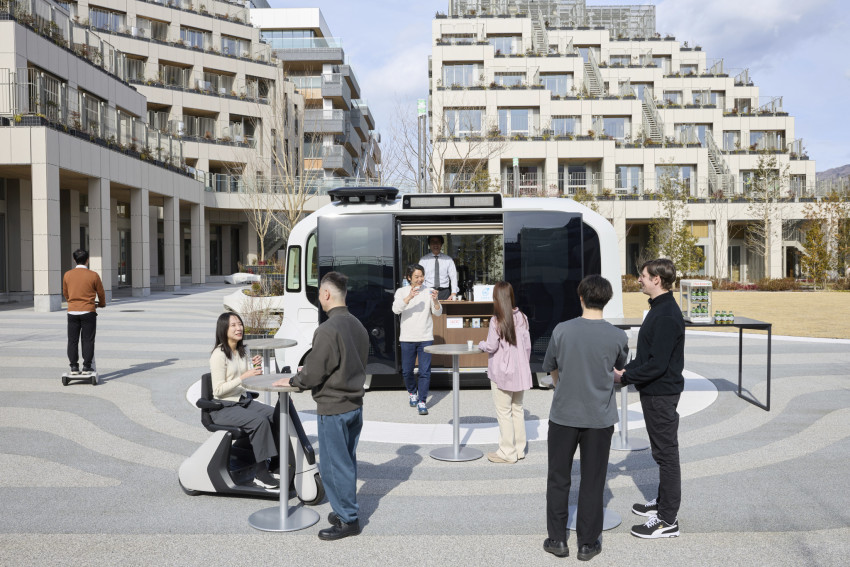Woven City near Mount Fuji is where Japanese automaker Toyota plans to test everyday living with robotics, artificial intelligence and autonomous zero-emissions transportation.
Daisuke Toyoda, an executive in charge of the project from the automaker's founding family, stressed it’s not “a smart city.”
“We’re making a test course for mobility so that’s a little bit different. We’re not a real estate developer,” he said Saturday during a tour of the facility in Shizuoka Prefecture, where the first phase of construction was completed.
The Associated Press was the first foreign media to get a preview of the $10 billion Woven City.
The first phase spans 47,000 square meters, roughly the size of about five baseball fields. When completed, it will be 294,000 square meters.
Built on the grounds of a shuttered Toyota auto plant, it’s meant to be a place where researchers and startups come together to share ideas, according to Toyoda.
Ambitious plans for futuristic cities have sputtered or are unfinished, including one proposed by Google’s parent company Alphabet in Toronto; “Neom” in Saudi Arabia; a project near San Francisco, spearheaded by a former Goldman Sachs trader, and Masdar City next to Abu Dhabi’s airport.
Woven City’s construction began in 2021. All the buildings are connected by underground passageways, where autonomous vehicles will scuttle around collecting garbage and making deliveries.
No one is living there yet. The first residents will total just 100 people.
Called “weavers,” they’re workers at Toyota and partner companies, including instant noodle maker Nissin and Daikin, which manufactures air-conditioners. Coffee maker UCC was serving hot drinks from an autonomous-drive bus, parked in a square surrounded by still-empty apartment complexes.
The city’s name honors Toyota’s beginnings as a maker of automatic textile looms. Sakichi Toyoda, Daisuke Toyoda’s great-great-grandfather, just wanted to make life easier for his mother, who toiled on a manual loom.
There was little talk of using electric vehicles, an area where Toyota has lagged. While Tesla and Byd emerged as big EV players, Toyota has been pushing hydrogen, the energy of choice in Woven City.
Toyota officials acknowledged it doesn’t expect to make money from Woven City, at least not for years.
Keisuke Konishi, auto analyst at Quick Corporate Valuation Research Center, believes Toyota wants to work on robotic rides to rival Google’s Waymo — even if it means building an entire complex.
“Toyota has the money to do all that,” he said.
© Copyright 2025 The Associated Press. All rights reserved. This material may not be published, broadcast, rewritten or redistributed without permission.















17 Comments
Login to comment
3RENSHO
WOW!... Utopia!
BigP
Toyota rolling in spare cash. Where did Nissan go wrong?
sakurasuki
Rich in cash for now, those cash could have better use to get market dominance. However Japan Inc just being Japan Inc.
https://www.bloomberg.com/graphics/2024-china-outshines-japan-cars-southeast-asia/
https://asia.nikkei.com/Business/Automobiles/Japan-s-automakers-lose-market-share-in-China-Thailand-as-EVs-spread
https://www.asahi.com/ajw/articles/15580003
JeffLee
Ten billion dollars is pretty damn ambitious.
I wonder if those tiny Japanese trees will be allowed to grow enough and not be pruned so as to provide shade that will cool the ground in the summer and allow pleasant outdoor seating in spring and fall. That approach, common throughout the world, would be rare for Japan.
There's a red flag. So forget your zero-emission goals. That's a company that sells energy-sucking products that need to be set at high in winter and summer - to suck even more energy -- due to Japan's lax regulations on insulation and other eco-performance features for building construction.
garypen
Looks kinda cool. I wouldn't mind having a condo there. My wife owned a Toyota once. So, put us on the list. (Just ignore that she worked at Nissan for a few years, after college.)
DeeZee
Japan pioneered the concept of smart cities and tried to build one in Australia in the 80's which they called a "multifunction polis". They never went through with it due to the negative attention and in my view China has surpassed Japan in this field, Japan would benefit from this only if it was geared towards helping their ageing population and allowed older people to live in dignity whilst removing the burden of young people having to support these pensioners.
kurisupisu
kohakuebisu
Sounds like an interesting experiment.
I do not like large windswept plaza type places covered with pavers or concrete, often found next to office blocks. A cafe with a terrace on any French street (or somewhere like Kichijoji) will be vastly superior to a food truck sitting in a sea of concrete. One of the best known books about architecture, Christopher Alexander's A Pattern Language rails against oversized town square type places. The book essentially deconstructs historical architecture into features and talks about what works and doesn't work. Good architecture is just a matter of copying what has worked in the past. There is no need to reinvent the wheel in the name of the future.
https://www.iwritewordsgood.com/apl/patterns/apl061.htm
browny1
DeeZee - I remember the "Multi-Function Polis" attempt well.
A perfectly planned sustainable suburb, environmentally and technically decades ahead of it's time.
As you said, negative response from a small percentage of society with slogans like No Asian City helped it's demise. Also the eventual site chosen lacked the "Gold Coast" appeal some developers were hoping for.
The biggest factor though I suspect was the bursting of the economic miracle bubble in Japan and the crashing of the economy.
After the demise of the plan on the same site a local born Technology park development has occurred with widespread eco-friendly housing/lifestyle developments being built. It's been credited as a standout for sustainable urban development. If the original billions had flowed in in the 80s/90s, one wonders what amazing place could have been built.
Fast forward to 2025 in Japan one hopes that the Toyota concept is being handled expertly and proves to be a real basis for 21st/22ndC development that will be for all people - a people centric environment. They have the finance and ability.
If it's just a protype - like a car - created for interest just to see what we can do, then it will be a loss.
owzer
How is this news? Woven city has been in the works for years.
But I have heard from officers in companies with some connection to the project that it is definitely not proceeding to plan and has been scaled down significantly. Perhaps that should be the story.
Ego Sum Lux Mundi
Those people looked totally organic, authentic and in no way under the orders of a cameraman
kohakuebisu
This design might be futuristic but the all-weather pitch in the middle is definitely Showa. I hope the sign next to it has a list of rules like "no ball games".
Geeter Mckluskie
Congratulations! You've cracked the code of the ...photo shoot
The_Beagle
A 15-minute city?
BorisM
They sort-of did go through with the MFP, which morphed into the ugly, windswept desert called Docklands. A soulless mass of concrete where few people want to live, work, shop, play and dine out. It's the urban equivalent of a horse designed by a committee.
Jimizo
Haven’t heard that one for a while.
Do you think the elites in the city will force people to eat insects and oversee social credit scores?
JeffLee
On a sunny day, most people wouldn't sit or stand directly in the sun for a prolonged period of time unless they had to. This place needs shade, which the tiny trees don't provide. The grassy area would also go unused as a sitting space unless large shade producing trees are planted there with benches underneath.
I see these places in Japan, and they attract very few people who stop and spend time there. Nearly everyone is pedestrian on their way somewhere.